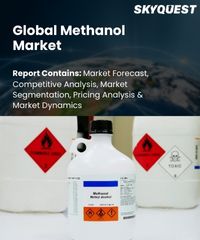
Report ID: SQMIG10G2022

Report ID:
SQMIG10G2022 |
Region:
Global |
Published Date: July, 2024
Pages:
157
|
Tables:
65 |
Figures:
75
Methanol Market size was valued at USD 0 Billion in 2023 and is poised to grow from USD 0 Billion in 2024 to USD 0 Billion by 2032, growing at a CAGR of 3.4% during the forecast period (2025-2032).
Methanol, also known as methyl alcohol, is a colorless, flammable, and volatile liquid. It is the simplest form of alcohol and has the chemical formula CH3OH. Methanol is commonly produced from natural gas, coal, and renewable sources such as biomass and waste. It is a versatile chemical with a wide range of applications. It is primarily used as a feedstock for the production of formaldehyde, acetic acid, and other chemicals. It is also used as a solvent, fuel additive, and antifreeze. Methanol can be blended with gasoline to create a methanol-gasoline blend, which can be used in vehicles that are designed to run on gasoline. It is also used as fuel in fuel cells and in some specialized vehicles that are specifically designed to run on methanol. It has a number of advantages as a fuel and feedstock. It is a relatively low-cost and widely available chemical that can be produced from a variety of feedstocks. It is also less toxic than other chemicals, such as benzene and toluene, which are commonly used in the chemical industry. However, methanol can be highly flammable and toxic if not handled properly, so it must be carefully stored, transported, and used according to strict safety guidelines.
With a wide range of applications in industries such as chemicals, automotive, construction, and energy, The global methanol market is witnessing significant growth, The chemical industry is the largest consumer of methanol, accounting for more than half of global methanol demand. Methanol is used as a feedstock for the production of formaldehyde, acetic acid, and other chemicals, which are used to make a wide range of products such as plastics, paints, adhesives, and textiles. The automotive industry is also a growing market for methanol, driven by increasing interest in low-emissions and renewable fuels. Methanol can be used as a fuel in modified gasoline engines or converted to dimethyl ether (DME) for use in diesel engines. This has led to the development of several pilot projects and initiatives to explore the potential of methanol as a low-emissions alternative fuel. Other growing markets for methanol include construction, where methanol is used as a solvent and in the production of formaldehyde-based resins and adhesives, and energy, where methanol can be used as a fuel for power generation or as a storage medium for renewable energy. Methanol market is expected to continue to grow in the coming years, driven by increasing demand for chemicals and alternative fuels, as well as by the potential for new applications in emerging markets such as energy storage and carbon capture. However, the market may also face challenges related to volatility in feedstock prices, competition from alternative fuels, and environmental concerns related to methanol production and use.
US Methanol Market is poised to grow at a sustainable CAGR for the next forecast year.
Our industry expert will work with you to provide you with customized data in a short amount of time.
REQUEST FREE CUSTOMIZATIONWant to customize this report? This report can be personalized according to your needs. Our analysts and industry experts will work directly with you to understand your requirements and provide you with customized data in a short amount of time. We offer $1000 worth of FREE customization at the time of purchase.

Report ID: SQMIG10G2022